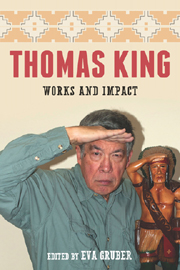Book contents
- Frontmatter
- Contents
- Preface
- Introduction
- Part 1 Works
- Part 2 Impact
- Part 3 Approaches
- 9 King's Contestatory Intertextualities: Sacred and Secular, Western and Indigenous
- 10 Thomas King's Humorous Traps
- 11 “Have I Got Stories—” and “Coyote Was There”: Thomas King's Use of Trickster Figures and the Transformation of Traditional Materials
- 12 “One Good Story”: Storytelling and Orality in Thomas King's Work
- 13 Maps, Borders, and Cultural Citizenship: Cartographic Negotiations in Thomas King's Work
- 14 One Good Protest: Thomas King, Indian Policy, and American Indian Activism
- 15 “Sometimes It Works and Sometimes It Doesn't”: Gender Blending and the Limits of Border Crossing in Green Grass, Running Water and Truth & Bright Water
- Part 4 Encounters
- Part 5 Thomas King—A Bibliography
- Notes on the Contributors
- Index
11 - “Have I Got Stories—” and “Coyote Was There”: Thomas King's Use of Trickster Figures and the Transformation of Traditional Materials
from Part 3 - Approaches
Published online by Cambridge University Press: 05 February 2013
- Frontmatter
- Contents
- Preface
- Introduction
- Part 1 Works
- Part 2 Impact
- Part 3 Approaches
- 9 King's Contestatory Intertextualities: Sacred and Secular, Western and Indigenous
- 10 Thomas King's Humorous Traps
- 11 “Have I Got Stories—” and “Coyote Was There”: Thomas King's Use of Trickster Figures and the Transformation of Traditional Materials
- 12 “One Good Story”: Storytelling and Orality in Thomas King's Work
- 13 Maps, Borders, and Cultural Citizenship: Cartographic Negotiations in Thomas King's Work
- 14 One Good Protest: Thomas King, Indian Policy, and American Indian Activism
- 15 “Sometimes It Works and Sometimes It Doesn't”: Gender Blending and the Limits of Border Crossing in Green Grass, Running Water and Truth & Bright Water
- Part 4 Encounters
- Part 5 Thomas King—A Bibliography
- Notes on the Contributors
- Index
Summary
Thomas King's engagement with trickster figures, Coyote in particular, has long roots. In his 1986 dissertation “Inventing the Indian: White Images, Native Oral Literature, and Contemporary Native Writers” King wrote: “If there is a need to understand a culture, and one can only hear a single story that the culture tells about itself, that story should probably be a creation story” (King 1986, 69), and of course Coyote was there at the beginning of things. In his anthology of contemporary Canadian Native literature in English, All My Relations, he depicts the trickster as “an important figure for Native writers for it allows us to create a particular kind of world in which the Judeo-Christian concern with good and evil and order and disorder is replaced with the more Native concern for balance and harmony” (King 1990b, xiii). In his collection of short stories, One Good Story, That One (1993) Coyote appears in the title story in a Native version of the biblical story of the Garden; multiple blue Coyotes transport rock-hard Indians to a space ship in “How Corporal Colin Sterling Saved Blossom, Alberta”; Coyote disastrously “fixes” the world in “The One About Coyote Going West”; and Coyote tries unsuccessfully to play ball with Columbus in “A Coyote Columbus Story.” Coyote is also central to King's major work Green Grass, Running Water, which opens and closes with Coyote's presence when the world began: “So. In the beginning, there was nothing. Just the water. Coyote was there …” (1993a, 1).
- Type
- Chapter
- Information
- Thomas KingWorks and Impact, pp. 184 - 198Publisher: Boydell & BrewerPrint publication year: 2012



